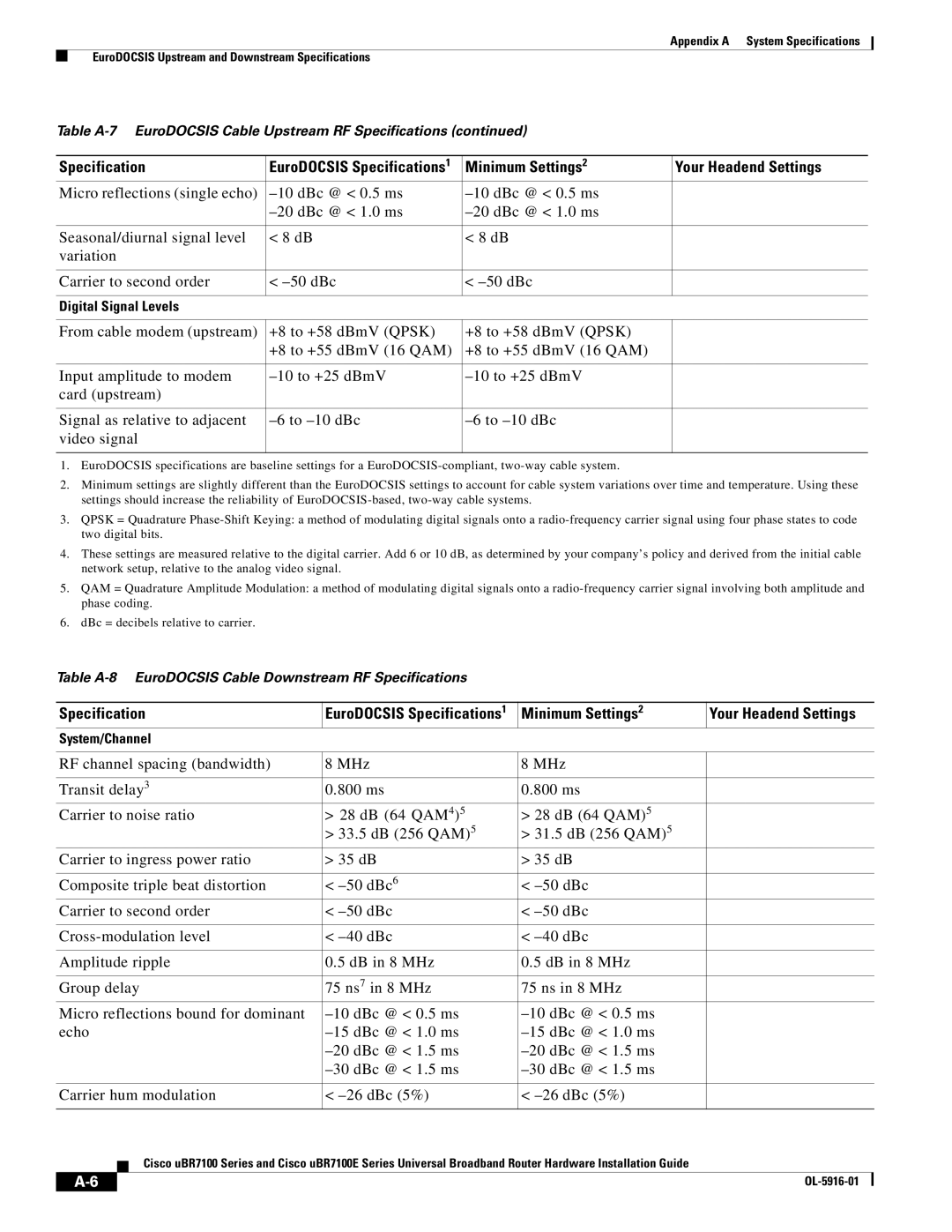Appendix A System Specifications
EuroDOCSIS Upstream and Downstream Specifications
Table
Specification | EuroDOCSIS Specifications1 | Minimum Settings2 | Your Headend Settings |
Micro reflections (single echo) |
| ||
|
| ||
|
|
|
|
Seasonal/diurnal signal level | < 8 dB | < 8 dB |
|
variation |
|
|
|
|
|
|
|
Carrier to second order | < | < |
|
|
|
|
|
Digital Signal Levels |
|
|
|
|
|
|
|
From cable modem (upstream) | +8 to +58 dBmV (QPSK) | +8 to +58 dBmV (QPSK) |
|
| +8 to +55 dBmV (16 QAM) | +8 to +55 dBmV (16 QAM) |
|
|
|
|
|
Input amplitude to modem |
| ||
card (upstream) |
|
|
|
|
|
|
|
Signal as relative to adjacent |
| ||
video signal |
|
|
|
|
|
|
|
1.EuroDOCSIS specifications are baseline settings for a
2.Minimum settings are slightly different than the EuroDOCSIS settings to account for cable system variations over time and temperature. Using these settings should increase the reliability of
3.QPSK = Quadrature
4.These settings are measured relative to the digital carrier. Add 6 or 10 dB, as determined by your company’s policy and derived from the initial cable network setup, relative to the analog video signal.
5.QAM = Quadrature Amplitude Modulation: a method of modulating digital signals onto a
6.dBc = decibels relative to carrier.
Table A-8 EuroDOCSIS Cable Downstream RF Specifications
| Specification | EuroDOCSIS Specifications1 | Minimum Settings2 | Your Headend Settings | |||
| System/Channel |
|
|
|
| ||
|
|
|
|
|
| ||
| RF channel spacing (bandwidth) | 8 MHz | 8 MHz |
|
| ||
|
|
|
|
|
| ||
| Transit delay3 | 0.800 ms | 0.800 ms |
|
| ||
| Carrier to noise ratio | > 28 dB (64 QAM4)5 | > 28 dB (64 QAM)5 |
|
| ||
|
|
|
| > 33.5 dB (256 QAM)5 | > 31.5 dB (256 QAM)5 |
|
|
| Carrier to ingress power ratio | > 35 dB | > 35 dB |
|
| ||
|
|
|
|
|
| ||
| Composite triple beat distortion | < | < |
|
| ||
| Carrier to second order | < | < |
|
| ||
|
|
|
|
|
| ||
| < | < |
|
| |||
|
|
|
|
|
| ||
| Amplitude ripple | 0.5 dB in 8 MHz | 0.5 dB in 8 MHz |
|
| ||
|
|
|
|
|
| ||
| Group delay | 75 ns7 in 8 MHz | 75 ns in 8 MHz |
|
| ||
| Micro reflections bound for dominant |
|
| ||||
| echo |
|
| ||||
|
|
|
|
|
| ||
|
|
|
|
|
| ||
|
|
|
|
|
| ||
| Carrier hum modulation | < | < |
|
| ||
|
|
|
|
|
|
|
|
|
|
| Cisco uBR7100 Series and Cisco uBR7100E Series Universal Broadband Router Hardware Installation Guide |
|
| ||
|
|
|
|
| |||
|
|
|
|
|
|
|
|
|
|
|
|
|
|
| |
|
|
|
|
|
| ||
